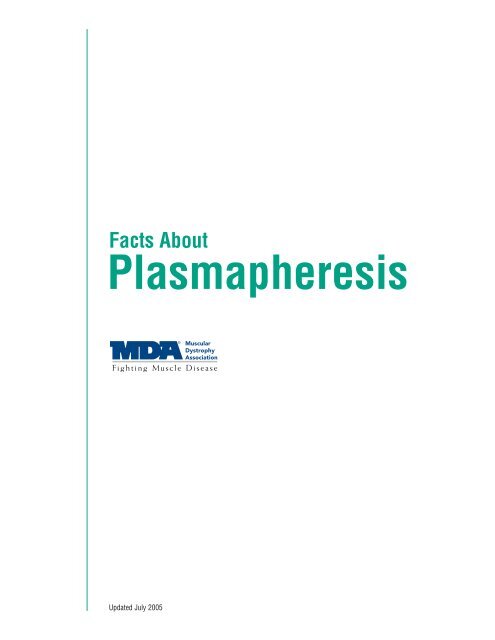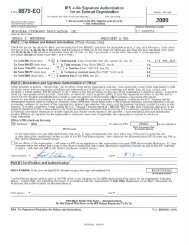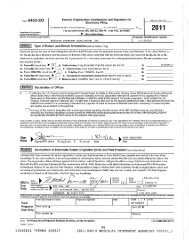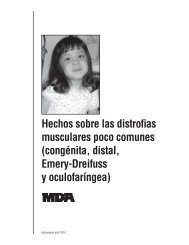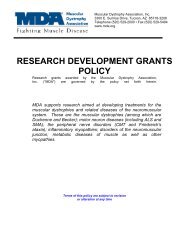Facts About Plasmapheresis - Muscular Dystrophy Association
Facts About Plasmapheresis - Muscular Dystrophy Association
Facts About Plasmapheresis - Muscular Dystrophy Association
Create successful ePaper yourself
Turn your PDF publications into a flip-book with our unique Google optimized e-Paper software.
<strong>Facts</strong> <strong>About</strong><strong>Plasmapheresis</strong>Updated July 2005
Dr. Peter Dau helped developplasmapheresis in the 1970s withMDA support. At that time, hewas at Children’s Hospital of SanFrancisco. He’s now at EvanstonHospital in Evanston, Ill.<strong>Plasmapheresis</strong> and Autoimmune DiseaseMany diseases, including myastheniagravis, Lambert-Eaton syndrome,Guillain-Barré syndrome and others, arecaused by a so-called autoimmune, orself-immune, process. In autoimmuneconditions, the body’s immune systemmistakenly turns against itself, attackingits own tissues. Some of the specializedcells involved in this process can attacktissues directly, while others can producesubstances known as antibodies that circulatein the blood and carry out the attack.Antibodies produced against the body’sown tissues are known as autoantibodies.Treatment with medications that suppressthe activities of the immune systemand/or reduce inflammation of tissueshas been the most common approachto autoimmune disease for more than30 years. Many new immunosuppressantshave become available since the1960s, but all the medications used totreat autoimmune disease have seriousside effects when taken in high doses formonths or years.In the 1970s, with the support ofthe <strong>Muscular</strong> <strong>Dystrophy</strong> <strong>Association</strong>,researchers developed a new approach tothe treatment of autoimmune conditions.Instead of trying to change the immunesystem with medication alone, theythought it might be possible to mechanicallyremove autoantibodies from thebloodstream in a process similar to thatused in an “artificial kidney,” or dialysis,treatment. The procedure became knownas plasmapheresis, meaning plasmaseparation. It’s also known as plasmaexchange.Medications that suppress the immunesystem or reduce inflammation often arecombined with plasmapheresis, but theyusually can be given in lower doses thanwhen used alone.Today, plasmapheresis is widely acceptedfor the treatment of myasthenia gravis,Lambert-Eaton syndrome, Guillain-Barrésyndrome and chronic demyelinatingpolyneuropathy. Its effectiveness in otherconditions, such as multiple sclerosis,polymyositis and dermatomyositis, is notas well-established.What is plasmapheresis?<strong>Plasmapheresis</strong> is a process in whichthe fluid part of the blood, called plasma,is removed from blood cells by a deviceknown as a cell separator. The separatorworks either by passing the blood athigh speed to separate the cells from thefluid or by passing the blood througha membrane with pores so small thatonly the fluid part of the blood can passthrough. The cells are returned to theperson undergoing treatment, while theplasma, which contains the antibodies, isdiscarded and replaced with other fluids.Medication to keep the blood from clotting(an anticoagulant) is given through a veinduring the procedure.What’s involved in aplasmapheresis treatment?A plasmapheresis treatment takes severalhours and can be done on an outpatientbasis. It can be uncomfortable but isnormally not painful. The number of treatmentsneeded varies greatly dependingon the particular disease and the person’sgeneral condition. An average course ofplasma exchange is six to 10 treatmentsover two to 10 weeks. In some centers,treatments are performed once a week,while in others, more than one weeklytreatment is done.A person undergoing plasmapheresis canlie in a bed or sit in a reclining chair. Asmall, thin tube (catheter) is placed in a2 <strong>Plasmapheresis</strong> • ©2011 MDA
large vein, usually the one in the crook ofthe arm, and another tube is placed in theopposite hand or foot (so that at least onearm can move freely during the procedure).Blood is taken to the separator fromone tube, while the separated blood cells,combined with replacement fluids, arereturned to the patient through the othertube.The amount of blood outside the body atany one time is much less than the amountordinarily donated in a blood bank.Are there risks associatedwith plasmapheresis?Yes, but most can be controlled. Anyunusual symptoms should be immediatelyreported to the doctor or the person incharge of the procedure. Symptoms thatmay seem trivial sometimes herald theonset of a serious complication.The most common problem is a drop inblood pressure, which can be experiencedas faintness, dizziness, blurred vision,coldness, sweating or abdominal cramps.A drop in blood pressure is remedied bylowering the patient’s head, raising thelegs and giving intravenous fluid.Bleeding can occasionally occur becauseof the medications used to keep the bloodfrom clotting during the procedure. Someof these medications can cause otheradverse reactions, which begin with tinglingaround the mouth or in the limbs, musclecramps or a metallic taste in the mouth. Ifallowed to progress, these reactions canlead to an irregular heartbeat or seizures.An allergic reaction to the solutions usedto replace the plasma or to the sterilizingagents used for the tubing can be a trueemergency. This type of reaction usuallybegins with itching, wheezing or a rash.The plasma exchange must be stoppedand the person treated with intravenousmedications.Excessive suppression of the immune systemcan temporarily occur with plasmapheresis,since the procedure isn’t selectiveabout which antibodies it removes. Intime, the body can replenish its supply ofneeded antibodies, but some physiciansgive these intravenously after each plasmapheresistreatment. Outpatients mayhave to take special precautions againstinfection.Medication dosages need careful observationand adjustment in people being treatedwith plasmapheresis because somedrugs can be removed from the blood orchanged by the procedure.How long does it take tosee improvement?Improvement sometimes can occurwithin days, especially in myastheniagravis. In other conditions, especiallywhere there is extensive tissue damage,improvement is slower but still can occurwithin weeks.Does MDA pay forplasmapheresis?MDA supported pioneering research todevelop plasmapheresis. However, paymentfor this procedure is not among themany services included in MDA’s program.A number of health insurance plansdo cover the procedure.Where are plasmapheresistreatments offered?<strong>Plasmapheresis</strong> is performed at manymajor medical centers around the country.MDA clinic directors can offer adviceabout the availability of this treatment andits use for specific conditions.3 <strong>Plasmapheresis</strong> • ©2011 MDA
MDA’s Purpose and ProgramsThe <strong>Muscular</strong> <strong>Dystrophy</strong> <strong>Association</strong>fights neuromuscular diseases throughan unparalleled worldwide research effort.The following diseases are included inMDA’s program:<strong>Muscular</strong> DystrophiesMyotonic dystrophy (Steinert disease)Duchenne muscular dystrophyBecker muscular dystrophyLimb-girdle muscular dystrophyFacioscapulohumeral muscular dystrophyCongenital muscular dystrophyOculopharyngeal muscular dystrophyDistal muscular dystrophyEmery-Dreifuss muscular dystrophyMotor Neuron DiseasesAmyotrophic lateral sclerosis (ALS)Infantile progressive spinalmuscular atrophy(Type 1, Werdnig-Hoffmann disease)Intermediate spinal muscular atrophy(Type 2)Juvenile spinal muscular atrophy(Type 3, Kugelberg-Welander disease)Adult spinal muscular atrophy (Type 4)Spinal-bulbar muscular atrophy(Kennedy disease)Metabolic Diseases of MusclePhosphorylase deficiency (McArdle disease)Acid maltase deficiency (Pompe disease)Phosphofructokinase deficiency(Tarui disease)Debrancher enzyme deficiency(Cori or Forbes disease)Mitochondrial myopathyCarnitine deficiencyCarnitine palmityl transferase deficiencyPhosphoglycerate kinase deficiencyPhosphoglycerate mutase deficiencyLactate dehydrogenase deficiencyMyoadenylate deaminase deficiencyMyopathies Due to EndocrineAbnormalitiesHyperthyroid myopathyHypothyroid myopathyOther MyopathiesMyotonia congenitaParamyotonia congenitaCentral core diseaseNemaline myopathyMyotubular myopathyPeriodic paralysisMDA’s website, mda.org, isconstantly updated with the latestresearch news and informationabout the diseases in its program.Follow MDA on Facebook, Twitterand YouTube.mda.org • (800) 572-1717©2005, 2011, <strong>Muscular</strong> <strong>Dystrophy</strong><strong>Association</strong> Inc.Inflammatory MyopathiesPolymyositisDermatomyositisInclusion-body myositisDiseases of NeuromuscularJunctionMyasthenia gravisLambert-Eaton (myasthenic) syndromeCongenital myasthenic syndromesDiseases of Peripheral NerveCharcot-Marie-Tooth diseaseFriedreich’s ataxiaDejerine-Sottas diseaseP-206W 7/11<strong>Plasmapheresis</strong> • ©2011 MDA


